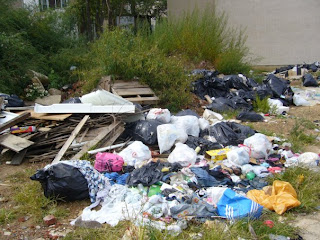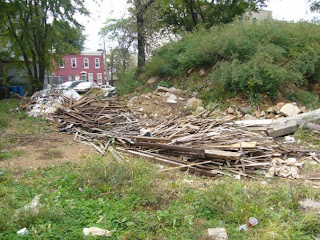

A grimy, bombed-out ghetto is not difficult to find in Philadelphia, but the towering oxidized steel pillars and rails of the Market-Frankfurt El lend this stretch of Market Street a special oppressiveness: here even the gray December sky is obstructed by industrial utility. It augments every emotion; colors every thought in the hues of old brick, junk weeds, weather wood and metal, asphalt, and mud. It is not a place that invites exploration. It instills in visitors a desire to hurry through, not to dawdle. It likely instills in residents a similar feeling.
Crime has long been an issue in the area. 52nd and Market was named #8 on a list of Philadelphia's Top Ten Drug Corners that reporter Steve Volk compiled for in 2007. That same year The Daily News called it "Philly's Deadliest Corner" after 16 shootings occurred there between February and May.


Litter prevention and neighborhood beautification happens at the local level. The group Keep Philadelphia Beautiful operates a website informing residents and business owners what they can do to prevent littering and graffiti, clear vacant lots, and plant and maintain trees. Litter attracts more litter, and KPB advises residents to keep their own property clean, and to put out their trash for collection only after 7 PM on the night before collection day in cans with attached lids. Residents can contact the Pennsylvania Horticultural Society to organize community-based maintenance programs to mow empty lots and remove trash, and the Philadelphia Anti-Graffiti Network to remove graffiti.
The area is in close proximity to three schools: Middle Years Alternative School at 49th and Chestnut, West Philadelphia High School at 48th and Walnut, and West Catholic High School at 45th and Chestnut. West Catholic has several extracurricular organizations, including the Community Service Corps, the LaSallian Youth, and the National Honor Society, who perform community service projects throughout the years, and would seem to be the perfect groups to try to clean up their own backyard. West Philly High has a Gardening Club that could work to organize community gardens in vacant lots. The Philadelphia School District requires mandatory school recycling programs, and Keep Philadelphia Beautiful's website outlines ways for schools to strengthen their recycling efforts. Kids who recycle in school should be more likely to implement what they've learned when they go home.
 One longer-term solution that would reduce trash and decay by improving the overall health of the area would be to reopen the 52nd Street SEPTA Regional Rail station. Closed since 1980, the station, situated in the psychological center of West Philadelphia, remains a sobering reminder of the area's more prosperous past. The station is often mentioned as part of the pipe dream to build a Schuylkill Valley Metro railroad connecting Philly to Reading in Berks County, but it could easily be opened on its own. It sits on the R5 line between 30th Street Station and Overbrook, and on the R6 between 30th Street and Wynnefield Ave, and so would serve to better connect the neighborhood to the region at large. This would benefit the area by providing residents with transportation to much-needed jobs in the suburbs, as well as providing psychological benefits. Having a regional rail station lets a community know that it is important enough that its residents should have access to other places, and other places should have access to it.
One longer-term solution that would reduce trash and decay by improving the overall health of the area would be to reopen the 52nd Street SEPTA Regional Rail station. Closed since 1980, the station, situated in the psychological center of West Philadelphia, remains a sobering reminder of the area's more prosperous past. The station is often mentioned as part of the pipe dream to build a Schuylkill Valley Metro railroad connecting Philly to Reading in Berks County, but it could easily be opened on its own. It sits on the R5 line between 30th Street Station and Overbrook, and on the R6 between 30th Street and Wynnefield Ave, and so would serve to better connect the neighborhood to the region at large. This would benefit the area by providing residents with transportation to much-needed jobs in the suburbs, as well as providing psychological benefits. Having a regional rail station lets a community know that it is important enough that its residents should have access to other places, and other places should have access to it.

 It is important to believe that no neighborhood is too far gone, that every place has a chance to come back. It is also important not to wait for the mechanisms of society, history, and economy to turn a place around. Much can be accomplished simply through the cooperation of like-minded residents, students, activists, and volunteers: the dreary, blighted places can be restored to the bright communities they deserve to be. To ultimately clean up Philadelphia we will need rail roads, factories, schools, and reforms, but much can be accomplished now simply with trees, gardens, murals, and clean streets.
It is important to believe that no neighborhood is too far gone, that every place has a chance to come back. It is also important not to wait for the mechanisms of society, history, and economy to turn a place around. Much can be accomplished simply through the cooperation of like-minded residents, students, activists, and volunteers: the dreary, blighted places can be restored to the bright communities they deserve to be. To ultimately clean up Philadelphia we will need rail roads, factories, schools, and reforms, but much can be accomplished now simply with trees, gardens, murals, and clean streets.
For more information on Keep Philadelphia Beautiful, visit www.keepphiladelphiabeautiful.org/.
For more information on the Pennsylvania Society, visit www.pennsylvaniahorticulturalsociety.org/.
For more information on the Philadelphia Anti-Graffiti Network, visit www.phila.gov/antigraffiti/.
Blog by Mike Deagler
Photos by Monica Schmidt




























